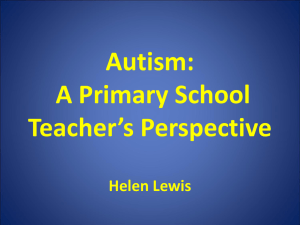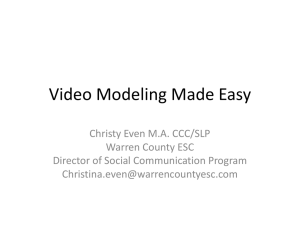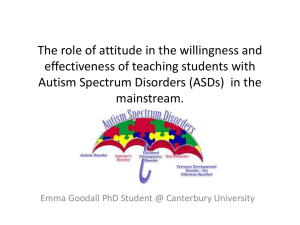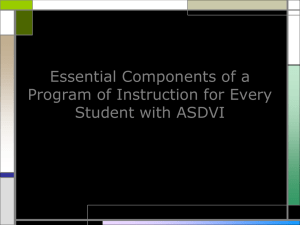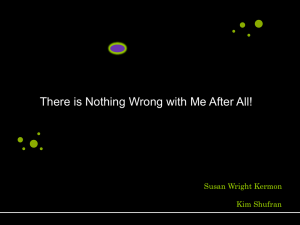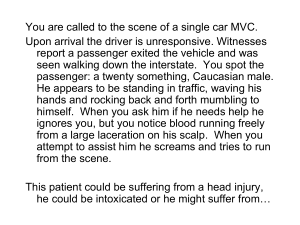ASD in later life - AWARES, the All Wales Autism Resource
advertisement
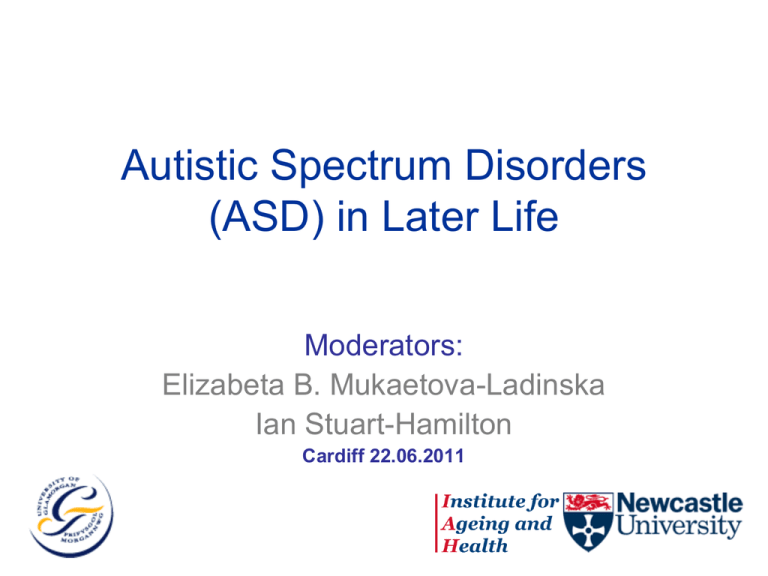
Autistic Spectrum Disorders (ASD) in Later Life Moderators: Elizabeta B. Mukaetova-Ladinska Ian Stuart-Hamilton Cardiff 22.06.2011 Aims: • Review the ASD perspectives in relation to demographics, relative carers experience, residential care needs • Requirement for new specifically designed cognitive assessment tools • Understanding brain aging in ASD Structure of the workshop • 10 min questionnaire re ASD and ageing • Ian: 10 min presentation on middle aged ASD people • Elizabeta:10 min presentation on ageing in ASD • 20 min discussion in smaller groups plus 10 min plenary, or 30 min open discussion on ASD topics. • Autism not a common diagnosis until the 1960s • ASD not a common diagnosis until the 1990s • What happened to all the people with ASD born pre-1990s? Source: Stuart-Hamilton, Griffith, Totsika et al. (2009) • Assuming a conservative incidence rate of 0.6%, in Wales: • High proportion of children identified • 15% of 20-40 year-olds • Practically zero over-forties Extrapolated from: Supporting People with Autism Through Adulthood (National Audit Office, 2009) • GPs estimated number of new patients with ASD over six month period: • Out of avg. 1500 patients aged 16-60, thought they saw 2. • Actual figure probably 9. • Circa 120,000 people of working age with undiagnosed ASD. Source: PsychInfo • >26,000 research papers on ASD in last 10 years • <20 study older adults and most of these single case studies • Study conducted was intentionally selective and is preliminary. • Recruited very high functioning adults with ASD who were computer literate. • Also interested in those who were undiagnosed but thought they might have ASD. Formal Diagnosis No Formal Diagnosis n 14 15 Mean Age 48.50 46.87 Mean EuroQol Health 50.29 58.67 Mean K6 Psych. Distress 19.14 17.07 Mean AQ 32.64 27.47 No sig. diffs. between groups, but all scores above clinical threshold. Category General UK Pop.* Formal Diagnosis No Formal Diagnosis Mobility No problem Problem 90 10 64 36 75 25 Self-Care No problem Problem 96 4 79 21 94 6 Usual Activities No problem Problem 90 10 43 57 56 44 Pain/ Discomfort No problem Problem 74 26 42 58 56 44 Anxiety/ Depression No problem Problem 81 19 21 79 19 81 No sig differences between FD & NFD groups Sig difference (2(df=4) = 76.788; p<.001) between ASD gp and general population * From Kind, Dolan, Gudex and Williams (1998) Conclusions: • Even in the very highest functioning people with ASD, there are serious problems • Little difference between formally diagnosed and non-formally diagnosed • The symptoms are real, present, and potentially life-shortening Elizabeta’s slides ASD: Demographics • Substantial change in demographics in XXI century • By 2026y in UK 1.7 million elderly adults with will need some type of 24h care • At least 1% of them will be on the ASD spectrum • How many of them will be undiagnosed ASD and high functioning Asperger? ASD in elderly: Current situation 1% ? Undiagnosed ASD ? Services: Social, clinical, care services Education Ageing and ASD: Current state • Very limited research!!! • How to diagnose an elderly with ASD? • Elderly ASD referred due to affective disorders (anxiety/depression), cognitive and/or physical problems (James et al, Int J Geriatr Psychiatry, 2006) • 1:3 elderly will develop dementia - no data regarding ASD • Case reports re Alzheimer’s disease, Vascular (Naidu et al, 2006, James et al, 2006) and Frontotemporal lobe dementia (Mukaetova-Ladinska et al, unpublished) in ASD • No large scale studies conducted to date And in clinical reality…. • Elderly people with ASD (not diagnosed) admitted on medical wards • NCL Liaison OAP team: elderly ASD with behavioral problems (‘bizarre behavior’, anxiety, aggression, memory problems, suicidal ideation, serious suicidal attempts) • Mental capacity assessments (facilitating communication) Examples - David • 84y man, with failing mobility over last 5 years. Expecting a an elective hip surgery • Retired academic, living alone, in ‘regular’ touch with family (‘once in 2 years’), no social contacts, limited contact (over telephone) with carr taker • Decided to take his own life one Saturday am, after waking with pain. Left a massage re his plan on daughter’s answer-phone, and wrote 3 letter (and posted them) • Run hot bath, and ‘wasted time’ on choosing the right knife, and had superficial neck wounds. • Not depressed, worried re caretaker finding blood in his home. • Family provides history of longstanding ‘odd behavior', having rituals, being rigid and anxious. Publications on ASD Mukaetova-Ladinska et al, Int J Geriatr Psychiatry. 2011 in press How ASD subjects age: 20 years outcome for ASD adults IQ test results Childhood Adult 32.5 7.2 y (3.1-25.9y) (22.3-46.4y) Nonverbal IQ 87.68 (65-115) 89.09 (57-144) Verbal IQ 78.72 (51-114) 89.10 (51-139) Full scale IQ 83.68 (36-137) 88.93 (50-140) IQ scores: substantial improvement in 33%, loss in 23%. Farley et al, Autism Res 2009 How to identify those that will improve? How are they going to age? Cognitive changes in elderly (64±7years) high functioning ASD Impairments in sustained attention, working memory and fluency, Geurts and Vissers: J Autism Dev Disord. 2011 in press How to diagnose ASD in older adults? Clinical diagnosis Clinical problems: • • • • Lack of collateral information Lack of developmental history How to diagnose ASD in elderly? What are the consequences of misdiagnosing ASD for psychosis and affective disorders for the ASD individuals and their families? • Impact of overlooking ASD in treatment of serious medical conditions • Are the clinical tools adequate for the elderly population? (elderly have higher score. Ray: ‘The right answer is…’) • Dilemma of non-verbal communication in elderly ASD? Clinical diagnosis of ASD in older adults • Autism Diagnostic Observation Scale (ADOS) – adapted for use in older adults (Brugha et al, 2009; Bastiaansen et al 2010) • Diagnostic Interview for Social and Communication disorders (DISCO) (Wing et al, 2002: designed for all age spectrum, needs to be validated for older adults • Autistic Spectrum Quotient (AQ; Baron-Cohen et al, 2005) AQ-20 used in older adults (Brugha et al, 2011) • Empathy Quotient (EQ, Baron-Cohen et al, 2005) • Friendship Questionnaire (Baron-Cohen et al, 2003) Imaging to aid diagnosis of ASD in older adults? Increase in white matter in ASD differentiate them from controls (adults and children) (voxel-based meta-analysis) Radua et al, Psychol Med. 2011 Jul;41(7):1539-50. Diffusion tensor imaging shows widespread white matter compromise in autism spectrum disorder (children and adolescents Shukla et al, J Child Psychol Psychiatry. 2011 Mar;52(3):286-95. Age-related temporo-parietal cortical thinning in ASD ASD vs. C ASD>17 years vs. ASD<17 years Wallace et al, Brain. 2010 Dec;133(Pt 12):3745-54. Cortical changes in ASD adults (40-69years) ASD>C (excess pattern) ASD<C (negative pattern) Ecker et al, J Neurosci. 2010 Aug 11;30(32):10612-23. Topics • Do older people with ASD provide us with challenges different from older people with other atypical conditions? • Should we be searching for older people with ASD or just leave things as they are? • If we had the resources, what form would a service for older people with ASD take? Conclusions Is ageing in ASD an important clinical problem? • Clinical management is an imperative: assessments for mental capacity, cognition, mental health issues are a common reason for referrals to liaison OAP services, that lead to clinical diagnosis of ASD. • Addressing medical health problems adequately • ? Clinical expertise to treat elderly ASD • ? Educating professionals • Enhancing communication with ASD individuals, their families and carers,and service providers • ? Service provision Workshop recommendations for improving health and social care for older ASD adults (Newcastle 2009)


